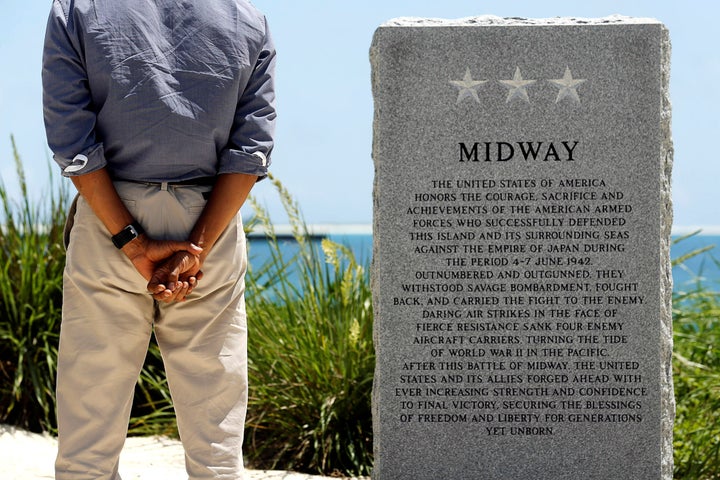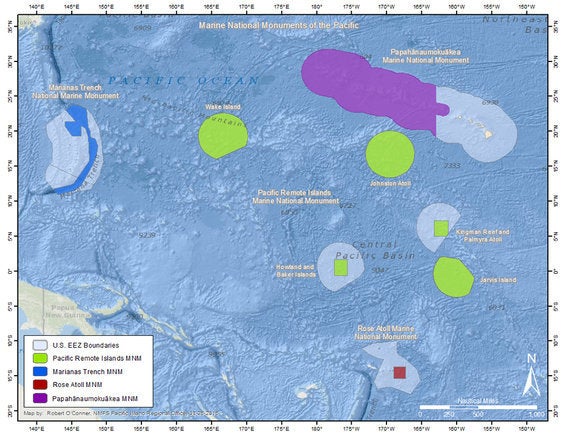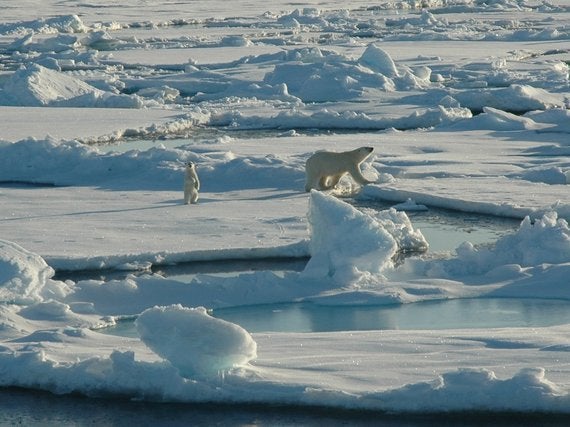
While kudos are due President Obama for his recent Marine National Monument designations in the Pacific and off New England, it is significant that these actions mostly protect remote, deep-water areas where there is little human use, little threat, and little political opposition. Conspicuously absent from the monument designations (so far) are shallower waters over continental shelves, where the greatest biological productivity, human use, and ecosystem degradation occur.
In the final months of his administration, Mr. Obama needs to correct this spectacular omission by designating additional monuments in ecologically sensitive continental shelf waters, including Alaska, and negotiate an agreement with other Arctic nations for a High Arctic Marine Sanctuary.
The five existing Marine National Monuments (MNMs) in U.S. waters include the following:
Papahanaumoukuakea MNM, in the Northwestern Hawaiian Islands, established in 2006 by Pres. G. W. Bush, expanded from 139,737 mi2 to 582,578 mi2 in Aug. 2016 by Pres. Obama, encompassing all waters surrounding the islands out to the 200-mile limit of the Exclusive Economic Zone (EEZ). The monument expansion makes this one of the largest marine protected areas in the world, while only displacing an estimated 5 percent of commercial fishing (mostly pelagic long lining) in the broader region.
Pacific Remote Islands MNM, established by Pres. Bush in Jan. 2009, and expanded (to 200 miles offshore) by Pres. Obama in 2014 from 86,888 mi2 to 370,000 mi2, including remote tropical islands and waters of Wake, Baker, Jarvis, Howland, Johnston Atoll, Kingman Reef, and Palmyra Atoll.
Marianas Trench MNM, established Jan. 2009, covers 96,714 mi2, including the islands, trench, and volcanic units in the Northern Mariana Islands. The monument includes the deepest point in the world ocean ― the Challenger Deep - at 36,070 feet deep.
Rose Atoll MNM, established Jan. 2009, a pristine coral atoll and offshore waters covering 13,436 mi2 in American Samoa.
Northeast Canyons and Seamounts MNM, established Sept. 2016, covering 4,913 mi2, including four seamounts and three deep-sea canyons, 130 miles off the coast of New England ― the first marine monument in the Atlantic.

As our most restrictive marine protected area designation, Marine National Monuments generally prohibit commercial fishing, offshore drilling, deep-sea mining, and other harmful industrial activities.
In contrast with marine monuments, National Marine Sanctuaries are generally closer to shore, but are less protective and accommodate multiple uses. The thirteen existing National Marine Sanctuaries ― seven along the Pacific coast, three in the Northeast and Great Lakes, and three in the Southeast ― cover a total area of approximately 170,000 mi2.
Although there was much excitement in the marine conservation community in 2014 when, for the first time in decades, the federal government reopened the marine sanctuary nomination process, results to date have fallen far short of expectations. Of the six nominations so far, two (in freshwater) were approved ― Lake Michigan (WI), Mallows Bay in the Potomac River (MD); two are in consideration - Chumash Heritage (CA), and Lake Erie Quadrangle (PA); one ― Eubalaena Oculina (FL, northeast Atlantic coast) ― was withdrawn; and the largest sanctuary nomination to date ― the 554,000 mi2 of federal waters surrounding the Aleutian Islands off Alaska - was declined due to lack of local political support.
Mr. Obama is to be commended for the marine monuments and sanctuaries he has designated and expanded, but it is troubling that he has failed to address the most urgent marine conservation challenge in the nation ― productive, heavily exploited and declining coastal ecosystems on continental shelves.
One important ocean area Obama has all but ignored, and must protect before leaving office, is the extraordinary offshore region of Alaska.
Alaska’s seas and coasts are globally unique for their diversity, expanse, abundance of fish and wildlife, as well as their historical, cultural and economic importance. Half of the nation’s entire shoreline and three-fourths of our total continental shelf are in Alaska. Alaska’s 200-mile EEZ is more than twice the size of the state’s land area, and this vast ocean system supports the most abundant populations of fish, shellfish, seabirds and marine mammals in the nation, and some of the largest in the world.

But these extraordinary marine ecosystems are in decline, primarily due to overharvest, marine environmental changes, and climate change. Most of Alaska’s threatened and endangered species are marine animals, and many seabird and marine mammal populations are in serious decline - the result, many scientists suspect, of excessive commercial harvests of certain fish and marine mammal populations, in combination with changes in the ocean environment. Management by the National Marine Fisheries Service and the industry-led North Pacific Fishery Management Council has failed to slow or reverse Alaska’s marine ecological decline.
Logically, Alaska should be at the top of the administration’s shortlist for marine monument designation. However, due to strong political opposition in Alaska to any federal protections, to date there is not one square mile of permanently protected offshore federal waters in Alaska. This is a national disgrace, and Obama knows it.
Alaska’s offshore ecosystems clearly deserve permanent federal protections, yet so far, Mr. Obama has cowered from this challenge. Other than enacting a few limited withdrawals from offshore oil leasing in Alaska, which could be reversed by a future administration, the Obama administration has been virtually indistinguishable from the Bush administration in managing Alaska’s offshore waters.
Both Obama and Bush have picked low-hanging fruit by protecting remote areas with little human use, threat or political opposition. This boosts the total square miles in protected status, is politically easy, and looks good on the conservation scoreboard, but this simplistic approach misses the more critical conservation challenges in productive, heavily exploited near shore waters on continental shelves. The nation deserves better.
Had President Carter cowered in the face of local political opposition to his proposed federal land protections in Alaska decades ago, he wouldn’t have succeeded in enacting the most significant land conservation deal in U.S history ― the 1980 Alaska National Interest Land Conservation Act (ANILCA), which established 157 million acres of new national parks, monuments, preserves, and refuges on Alaska lands.
Similarly today, many industrial interests that have long-profited from Alaska’s offshore waters reflexively resist any proposals for permanent federal ocean protection. But these federal waters are co-owned and co-managed on behalf of all Americans, and their protection is clearly in the national interest. We now need Pres. Obama to be bold, and summon the same wisdom, courage, and transcendent national spirit as Pres. Carter did decades ago, and finish the ocean protection job he has started.
In his final months in office, Mr. Obama must make the right, yet politically difficult, decision to designate marine monuments in continental shelf waters. This should include at least three marine monuments in Alaska ― the Aleutian Islands (as previously nominated for sanctuary designation), Bering Strait, and the Arctic Coast. In addition, he should work to secure an agreement with other Arctic nations to establish a High Arctic Marine Sanctuary in international waters surrounding the North Pole.
Short of this, Mr. Obama’s ocean legacy grade will at best be an “I,” for “Incomplete.”

